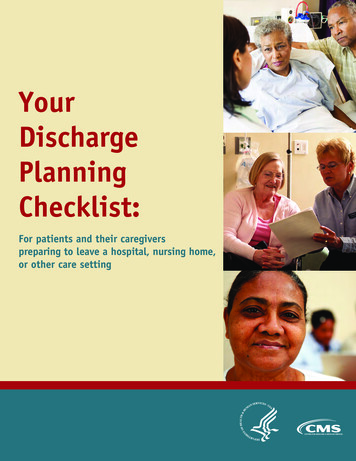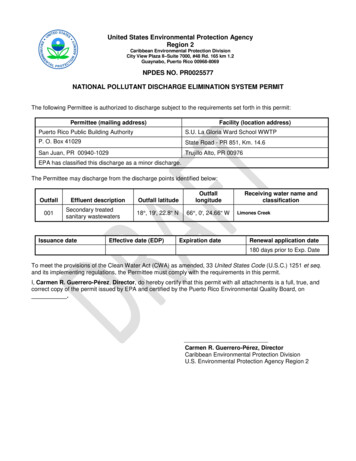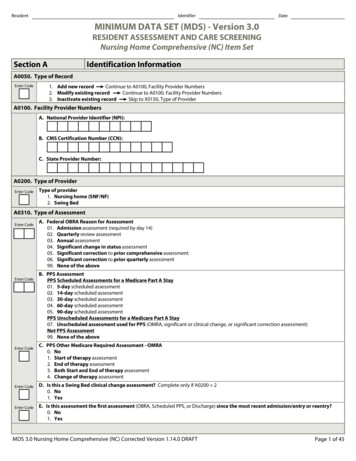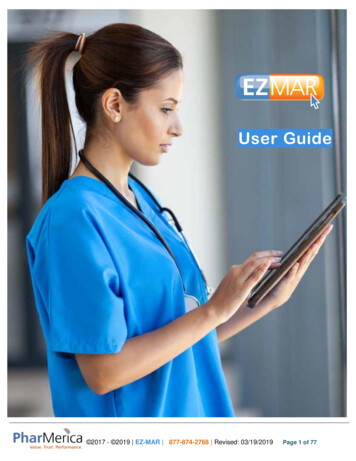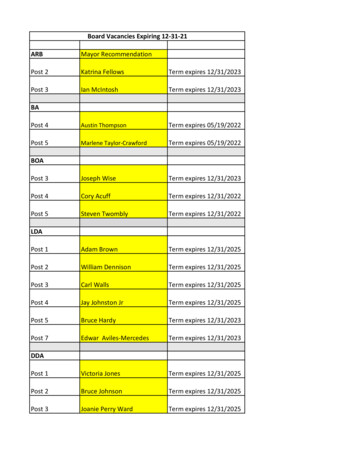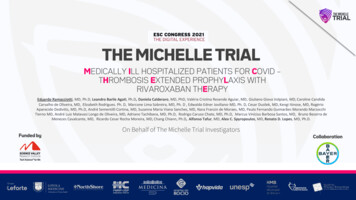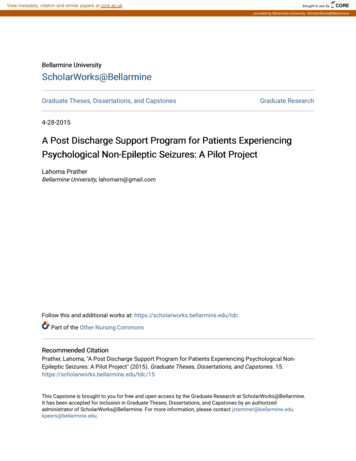
Transcription
View metadata, citation and similar papers at core.ac.ukbrought to you byCOREprovided by Bellarmine University: ScholarWorks@BellarmineBellarmine UniversityScholarWorks@BellarmineGraduate Theses, Dissertations, and CapstonesGraduate Research4-28-2015A Post Discharge Support Program for Patients ExperiencingPsychological Non-Epileptic Seizures: A Pilot ProjectLahoma PratherBellarmine University, lahomarn@gmail.comFollow this and additional works at: https://scholarworks.bellarmine.edu/tdcPart of the Other Nursing CommonsRecommended CitationPrather, Lahoma, "A Post Discharge Support Program for Patients Experiencing Psychological NonEpileptic Seizures: A Pilot Project" (2015). Graduate Theses, Dissertations, and Capstones. 15.https://scholarworks.bellarmine.edu/tdc/15This Capstone is brought to you for free and open access by the Graduate Research at ScholarWorks@Bellarmine.It has been accepted for inclusion in Graduate Theses, Dissertations, and Capstones by an authorizedadministrator of ScholarWorks@Bellarmine. For more information, please contact jstemmer@bellarmine.edu,kpeers@bellarmine.edu.
1Running head: PRATHER CAPSTONEA Post Discharge Support Program for Patients ExperiencingPsychological Non-Epileptic Seizures: A Pilot ProjectLahoma Prather
2PRATHER CAPSTONEAbstractRationale: There are no accepted standards of care for patients with psychological non-epilepticseizure (PNES) disorder. However the literature regarding PNES identified three commonthemes including acceptance of the diagnosis; consistent support and follow up; anddevelopment of appropriate outcome indicators. This pilot project was designed to address thesethemes rather than focus on a specific treatment modality.Methods: The pilot project was initiated at the University of Louisville Comprehensive EpilepsyCenter (CEC) to evaluate the feasibility of a post-discharge support program for the PNESpopulation. Outcomes identified for measurement included seizure frequency, health careutilization, anti-epileptic medication use and three quality of life indicators.Results: Ten patients were admitted to the program. The five intervention group patients reporteddeclines in seizure frequency, health care utilization and anti-epileptic medication use. Surveyreturn from both the intervention and control groups was minimal precluding statistical analyses.The patients in the intervention group were diverse with regard to psychosocial backgrounds,trauma history, and PNES triggers which allowed the team to view the pilot with regard topatient specific variables leading to the development of a PNES treatment readiness model.Conclusion: Though small in scale, this pilot project adds to the body of knowledge about care ofthe patient diagnosed with PNES by focusing on identified care themes rather than specifictreatment modalities. The Modified RED program will be further developed and evaluated. Inaddition, the Shafer-Prather PNES treatment readiness model being developed by the team willbe evaluated in future work.
PRATHER CAPSTONE31. IntroductionOver the last decade healthcare providers and researchers have published more frequentlyabout the nature and cause of psychological non-epileptic seizures (PNES). It is generally agreedthat PNES are unconscious, maladaptive coping mechanisms related to past trauma, abuse and/oroverwhelming stress (Ali, Jabeen, Arain, Wassef, & Ibrahim, 2011; Baslet, Roiko, & Prensky,2010; Myers, Fleming, Lancman, Perrine, & Lancman, 2013; Reuber, Pukrop, Bauer, Derfuss, &Elger, 2004). While the understanding, diagnostic methods, and even name of PNES haveevolved over time, guidelines for effective, sustainable treatment continue to be illusive (Dikel,Fennell, & Gilmore, 2003; Lally, Spence, McCusker, Craig, & Morrow, 2010; Reuber, 2007).Most published treatment studies examine psychiatric interventions as the primarytreatment for PNES (Baslet, 2012; Hall-Patch et al., 2010; Mayor, Howlett, Grunewald, &Reuber, 2010). The psychiatric treatments utilized vary and include cognitive behavioral therapy,group psychodynamic therapy, group and individual educational therapy, guided self- helpinterventions, and eye movement desensitization and reprocessing. Each of these treatmentsfocus on assisting patients in processing past trauma and developing healthy, effective copingmechanisms (Atnas & Lippold, 2013; Goldstein et al., 2010; LaFrance et al., 2009; Oto, 2013;Metin et al., 2013; Quinn, Schofield, & Middleton, 2012; Thompson et al., 2013). These studiesshow promising areas for future work but have not produced a generally accepted standard ofcare (Goldstein et al., 2010; LaFrance et al., 2009; Quinn, Schofield, & Middleton, 2012; Sharpeet al., 2011).While no accepted standards of care have been developed, the literature regarding PNESidentified three common themes that guided the development of this pilot project, includingacceptance of the diagnosis; consistent support and follow up; and development of appropriate
PRATHER CAPSTONE4outcome indicators. This pilot project was designed to address these themes rather than focus ona specific treatment modality.1.1Understanding and Acceptance of the DiagnosisIndividuals experiencing PNES frequently do not understand, and may not accept, theirnew diagnosis (Baxter et al., 2012; Thompson, Isaac, Rowse, Tooth, & Reuber, 2009). Manypatients with PNES have lived for years with the diagnosis of epilepsy. The change in diagnosisfrom epilepsy to PNES can be challenging, as it is a turn from a definable physical illness withgenerally accepted treatment plans, to a diagnosis that is not well known and requires delvinginto psychosocial areas of life that may not be easily penetrated. The journey to healing throughprocessing past trauma, abuse, or overwhelming stress may be more daunting than the originaldiagnosis of epilepsy (Baxter et al., 2012). Understanding the connection between psychologicalstressors and the physical manifestations of the seizures is frequently difficult for patients andtheir families (Baxter et al., 2012; Thompson et al, 2009; Stone, Binzer, & Sharpe, 2004).Effective treatment likely requires ongoing education and reinforcement of treatment plans(Karterud, Knizek, & Nakken, 2010).1.2Consistent Support and Follow upThe literature shows that, regardless of the specific psychological treatment modalitydeemed appropriate for PNES patients, there is need for consistent or increased support for afterdiagnosis (Mayor et al., 2013; Sharpe et al., 2011). Individuals experiencing PNES often havesignificant psychiatric co-morbidities including anxiety, depression, posttraumatic stress disorder(PTSD) and suicidal ideation. Most healthcare providers discuss these co-morbidities, as well asPNES, in relation to past trauma or abuse in some manner when delivering the PNES diagnosisto patients (Hall-Patch et al., 2010; Thompson, Isaac, Rowse, Tooth, & Reuber, 2009). Once this
PRATHER CAPSTONE5discussion is held it is incumbent upon the healthcare provider to follow up with patients tovalidate they have the tools to deal with their issues (Reuber, Mitchell, Howlett, & Elger, 2005).Referrals to appropriate therapists, psychiatrists or other mental health providers are crucial inassuring the patient receives the support needed after diagnosis of PNES (Agrawal, Gaynor,Lomax, & Mula, 2014). However, appropriate referrals to therapists, psychiatrists or othermental health professionals for psychiatric services, along with consistent health provider followup, can be challenging from both a provider and patient perspective (Grimaldi, Dubuc, Kahane,Bougerol, & Vercuell, 2010; Lally, Spence, McCusker, Craig, & Morrow, 2010; Scevola et al.,2009). In addition, patients may fail to initiate or may discontinue treatment related to factorsincluding confusion and doubt about the diagnosis, lack of trust in health care providers, and/orlack of resources (Baslet & Prensky, 2013; Baxter et al., 2011; Thompson, Isaac, Rowse, Tooth,& Reuber, 2009). It is important that patients commit to a mutually agreed upon treatment planand follow up care and that the health care provider commit to providing appropriate levels ofsupport (Karterud, Knizek, & Nakken, 2010).1.3Development of Appropriate Outcome IndicatorsThe goal of treatment with epilepsy is seizure freedom, which is also the traditionalmetric examined for PNES outcomes (Mayor, et al., 2012; Duncan, Razvi, & Mulhern, 2011;McKenzie, Oto, Russell, Pelosi, & Duncan, 2010; Arain, Hamadani, Islam, & Abou-Khalil,2007; Reuber, Mitchell, Howlett, & Elger, 2005). However, while seizure frequency is a relevantoutcome measure, it is not the sole indicator of healing for PNES patients. Quality of life andability to function are also becoming expected key indicators of health status for PNES patients(Durrant, Rickards, & Cavanna, 2011; Mayor et al., 2012; Myers, Lancman, Laban-Grant,Matzner, & Lancman, 2012; Van Merade et al., 2004). In addition, decreases in health care
PRATHER CAPSTONE6utilization is also used to define successful treatment of individuals experiencing PNES;however, these decreases may not indicate true improvement. Accurate diagnosis may lessen anindividual’s or their family’s views of PNES as medical emergencies. This does not necessarilytranslate into improvement either in seizure frequency, level of functioning or quality of life(Jirsch, Ahmed, Maximova, & Gross, 2011; McKenzie, Oto, Russell, Pelosi, & Duncan, 2010).1.4Pilot ProjectThe University of Louisville Hospital Epilepsy Monitoring Unit admits approximatelythree hundred patients annually for evaluation of intractable seizures. Of this number, 30-40%are definitively diagnosed with PNES during admission. Our experience with PNES patientsmirrors the common themes found in the literature. It is not uncommon for patients to make thefirst report of trauma or abuse at the time of diagnosis which may cause distress and the need forintensive support for the patients and their families. Patients admitted to the unit who receive aPNES diagnosis are often shocked by the radical change in treatment plan and unsure of whattheir next steps entail. As reported in the literature we have observed that patients find it difficultto make the connection between psychological stressors and the physical manifestations of theseizures (Baxter et al., 2012; Thompson et al, 2009; Stone, Binzer, & Sharpe, 2004).To address the ongoing care issues of the patients with PNES who present for care at ourcenter, a post-discharge support program was created based on common literature themes andtreatment needs of this patient population. The post-discharge support program is a modifiedversion of the Re-engineered Discharge (RED) program created by Boston University MedicalCenter in conjunction with the Agency for Healthcare Research and Quality [AHRQ], 2013. TheBoston University RED program was designed to improve the discharge experience for patientswith chronic illnesses, as well as to decrease thirty day readmission rates for these patients. This
PRATHER CAPSTONE7was accomplished through patient education and post discharge support primarily through phonecalls (AHRQ, 2013). RED was originally designed to address chronic physical health conditions,such as congestive heart failure, and has been shown to be successful in decreasing readmissionsrates and improving patient outcomes (Jack et al., 2009). The program consists of twelvecomponents and includes a toolkit on the AHRQ website for healthcare providers interested ininitiating the RED program in their facilities (AHRQ, 2013). Modifications to the componentsand toolkit were made to tailor the program to the specific needs of PNES patients.This pilot project describes the Modified RED post-discharge support program andexamines the feasibility of its utilization for patients with PNES. The pilot project receivedapproval from the institutional review boards of University of Louisville Hospital, University ofLouisville, KentuckyOne Health, and Bellarmine University.2. Material and methods:2.1Participants/PopulationThe target population of the post-discharge support program was adult patients diagnosedwith PNES after admission to the University of Louisville Epilepsy Monitoring Unit. Patientsincluded were those over age eighteen admitted to the Epilepsy Monitoring Unit andsubsequently diagnosed with PNES during their admission. Both male and female patients wereincluded and there were no exclusions based on ethnicity or other demographic variables.Patients with the co-morbidity of epileptic seizures will be excluded from these guidelines.The project included an intervention and control group. The intervention group wasenrolled in the post-discharge support program while the control group received the standardcare of explanation of the diagnosis and suggested referral as needed. Patients were assigned togroups in an alternating manner.
8PRATHER CAPSTONE2.2StaffThe project was conducted by the medical director of the epilepsy monitoring unit whopresented the diagnosis and approached the patients about participation in the pilot project. Inaddition, an epilepsy nurse acting as discharge educator/coordinator, initiated and managed thedischarge support program, in conjunction with the medical director.2.2Modified RED ProgramThe intervention group participated in a modified version of the reengineered dischargeprogram (RED). Modifications to the RED program are outlined in Table 1. The medical directorand epilepsy nurse met on an ongoing basis to discuss the program and patient progress.Table 1Modified RED Program Process for Intervention GroupComponents of the RED(AHRQ, 2013)1. Ascertain need for andobtain languageassistance.2. Make appointments forfollow-up care (e.g.,medical appointments,post discharge tests/labs).3. Plan for the follow-upof results from tests orlabs that are pending atdischarge.Modifications for PNES Population No modifications necessary. Referrals were made at discharge as necessary includingreferrals to therapists, psychiatrists, and other mental healthcare providers. Education and consults with the epilepsy nurse or medicaldirector about PNES offered to all therapists, psychiatrists,and other mental health care providers working with thispopulation. The patient received the seizure monitoring results at thetime of diagnosis. Reinforcement of the diagnosis occurred at each follow upcall.4. Organize post dischargeoutpatient services andmedical equipment. Outpatient services needed such as a referral to therapists,psychiatrists, and other mental health providers andcommunity agencies were made at discharge. Ongoing assessments of service and equipment needs weremade during discharge calls which occurred at specifiedintervals after discharge.5. Identify the correctmedicines and a plan forthe patient to obtain them. Medications the patients were to continue taking wereincluded in the patient’s individual discharge booklet. The medical director had a discussion with each patient to
9PRATHER CAPSTONEexplain continuing or discontinuing anti-epilepticmedications. The epilepsy nurse followed up on the patients’understanding of continuing or discontinuing anti-epilepticmedications during each discharge call.6. Reconcile the dischargeplan with nationalguidelines. There are currently no national guidelines in place; however,the patient was assessed for distress or immediate needs andreferred appropriately.7. Teach a written dischargeplan the patient canunderstand. The discharge plan included in the RED toolkit wasmodified to address PNES and developed in conjunctionwith the patient and tailored to the patient’s specifictreatment plan.8. Educate the patient abouthis or her diagnosis andmedicines. A PNES patient education workbook was used during theeducation process. The workbook included space for patientsto document their personal experiences, possible triggers,and questions for providers. The epilepsy nurse encouragedthe patient to utilize the workbook and document theirexperiences to gain insight and understanding of theirpersonal story and to record questions for healthcareproviders. The PNES patient education workbook was forwarded totherapists, psychiatrists, and/or other mental health careproviders if requested by patient to aide in providerunderstanding of PNES. The medical director and epilepsy nurse were available toconsult with therapists, psychiatrists, and mental health careproviders as needed.9. Review with the patientwhat to do if a problemarises. Individualized written plans for crisis, emergent situations orseizure occurrence were created with the patient as part ofthe discharge process.10. Assess the degree of thepatient’s understanding ofthe discharge plan. The patient was asked to verbalize in their own words theirunderstanding of the diagnosis and encouraged to voiceconcerns and ask questions. This understanding was assessedprior to discharge at all follow up phone calls.11. Expedite transmission ofthe discharge summary toclinicians accepting careof the patient. Discharge summaries were forwarded to the referringhealthcare provider as well as providers the patient wasreferred to with the patient’s consent.12. Provide telephonereinforcement of thedischarge plan. The epilepsy nurse made follow up post-discharge calls at 1day/ 3 days/ 1 week/ 2 weeks/3 weeks/ 4 weeks/ bi-weeklyto 6 months and then every month to 1 year. A modified RED script was utilized for calls. Calls includedasking patients for a verbalization of the understanding of
10PRATHER CAPSTONEthe diagnosis, medication review, seizure frequency,healthcare utilization, assessment of current condition/needs,confirmation of follow up appointments, identifying barriersto follow up, and plan for seizure occurrence or emergencysituations. Assessment of patients’ experience with follow uppsychiatric care including therapists, psychiatrists and othermental health care providers was completed during followup calls to identify potential issues with care. Extra calls were made as needed based on patientneeds/outstanding issues.13. N/A2.3 The patient was asked to complete the Quality of Life inEpilepsy Short Form, The Brief Symptom Inventory and theGeneral Self-Efficacy Scale after diagnosis and at 1 month, 3months, 6 months and 1 year after discharge.Outcomes MeasuresOutcome measures for the project included the traditional metrics of seizure frequency,health care utilization, and anti-epileptic medication use. In addition, quality of life measureswere examined as well. Table 2 describes the outcomes measures and instruments.Table 2Outcomes Measures for PNES ProjectOutcome MeasureInstruments UsedPatient reports prior to discharge Seizure Frequencyand during follow-up calls Health Care Utilization Anti-Epileptic MedicationsUse Quality of Life Brief Symptom Inventory Quality of Life in Epilepsy General Self Efficacy ScaleData Collection Schedule Prior to diagnosis 1 day post discharge 3 days post discharge Weekly until 4 weeks postdischarge Every 2 weeks from 1-6months post discharge Monthly from 6-12 monthspost discharge Prior to discharge1 month post discharge3 months post discharge6 months post discharge12 months post discharge
PRATHER CAPSTONE11Measures Used2.34Brief Symptom InventoryThe Brief Symptom Inventory instrument is a fifty-three item Likert-type measure usedto assess patients for psychological problems and support care management decisions, as well asto evaluate patient progress during and after treatment. Patients rate the extent to which theyhave been bothered by specific symptoms in the previous seven days. The reported Cronbach’salpha ranges between .67-.96 with a test-retest reliability range of .68-.91(Prinz et al., 2013).2.35Quality of Life in Epilepsy Short form (QOLIE-31)The QOLIE-31 is the short form of an instrument that evaluates seventeen measures ofoverall quality of life, emotional well-being, role limitations due to emotional problems, socialsupport, social isolation, energy/fatigue, worry about seizures, medication effects, healthdiscouragement, work/driving/social function, attention/concentrations, language, memory,physical function, pain, role limitations due to physical problems, and health perceptions. Thereported Cronbach’s alpha is greater than .70 with test-retest reliability greater than .70 (Davies,Gibbons, Fitzpatrick, & Mackintosh, 2009).2.36General Self-Efficacy ScaleThe General Self-Efficacy Scale instrument is a ten item psychometric measure designedto assess a patient’s general sense of perceived self-efficacy with the aim of predicting ability tocope with daily stressors, as well as adaptation after experiencing stressful life events. This scalewas used to evaluate patient beliefs about their ability to cope with daily stressors as they workto replace PNES with health coping mechanisms. Reported Cronbach’s alpha for this instrumentis .95, with a test-retest reliability range of .69-.80 (Nilsson, Hagell, & Iwarsson, 2015).
PRATHER CAPSTONE123. Results3.1Baseline DataTen patients were admitted to the pilot project, five into the intervention group and fiveinto the control group. Overall, eight of the ten patients completed surveys prior to dischargewith two requesting to return their surveys via mail so they could be discharged expediently,neither of which were returned. In the intervention group, three actively participated in theproject and two could not be contacted after one week post-discharge. Of the five control grouppatients, only one returned surveys one month post discharge in spite of mailed reminders.3.12Intervention Group PatientsAll five of the intervention group patients were female and each had been previouslydiagnosed with epilepsy. Table 3 contains additional demographic information about the group.Intervention group patients were admitted over a six month period. Two of the five werefollowed up to four months post discharge with one patient newly admitted at the end of the sixmonth time frame and who remains an active participant in the Modified RED program. Eachpatient participated in an education session using the education workbook, as well as indeveloping their own personalized discharge plan. The intervention group was given a copy ofthe education workbook and discharge plan to take home with them at the time of discharge.All intervention group patients participated in follow up calls at one day, three days, andone week post discharge. Two patients no longer answered their phones or returned messagesafter one week post discharge but did not formally withdraw from the pilot. Neither hadexpressed any issues with the program during the last follow up call they participated in. Threeintervention group patients participated in ongoing discharge calls as explained in Step 12 of theModified RED program. Extra calls were made as needed to assist the patients in accessing
PRATHER CAPSTONE13resources as well as to provide continued education and support. Both of the patients followed upto four months returned surveys at one month and three months post discharge as outlined inStep 12 of the Modified RED program. The patient who was enrolled at the end of the six monthperiod has participated in follow up calls and has not been asked to complete the follow upsurveys at the time of this report.During the time period the five intervention group patients participated in the follow upcalls each of the patients was able to verbalize what PNES are, their personal journey todiagnosis and report how they were doing at the time of the call. None of the five expressedissues with the timing or frequency of the follow up calls and frequently noted they appreciatedthe support and felt the calls were helpful.3.13Control Group Patients.The control group consisted of two male and three female patients. All five control grouppatients had been previously diagnosed with epilepsy. While all five verbalized understanding oftheir expected participation in the pilot, only one of the five control group patients returnedsurveys after their discharge, even with reminders sent by mail. None of the five control grouppatients were followed on an outpatient basis by the medical director so there was no contactfrom the team after discharge with the exception of the mailed reminders. Additionaldemographic information about the control group patients may be found in Table 3.
14PRATHER CAPSTONETable 3Intervention and Control Group Patient DemographicsDemographicsInterventionGroup (n 5)Age, mean, years (SD)28.0 (5.66)Gender (% female)100Marital status (% married)40Ethnicity (% Caucasian)80Employment (% employed)60Trauma history (% confirmed)100Psychiatric co-morbidities (%)80Age at onset of seizures, mean, years (SD)24.0 (4.74)Previous diagnosis of epilepsy (%)80Previous anti-epileptic medication (%)80Time to PNES diagnosis, mean, months (SD)48.6 (74.95)3.2Outcome Indicators3.21Seizure FrequencyControlGroup (n 5)48.6 (12.62)60601002010010033.8 (14.25)100100180.0 (129.52)While active in the program all of the intervention group patients reported via phone calla decline in seizure frequency post diagnosis at week one and month four as shown in Table 4.3.22Health Care Utilization for PNESIntervention group patients reported multiple physician consults, ER visits and at leastone hospitalization prior to receiving the diagnosis. During the time period they were active inthe program (range one week-four months) none of the patients in the intervention groupreported accessing care for seizures after discharge as shown in Table 4.3.23Anti-Epileptic Medication UseAll but one of the intervention group patients was taking anti-epileptic medications onadmission to the epilepsy monitoring unit (range one-three medications). All medicationsprescribed for seizures were discontinued at discharge for the four intervention group patientstaking them and, per patient report, none were restarted during the time period each interventiongroup patient was active in the program. The control group patients were left on the antiepileptic
15PRATHER CAPSTONEmedications they had taken prior to diagnosis and advised to discuss discontinuation of thesemedications with their primary provider after discharge.Table 4Intervention Group Outcomes 1 Week and 4 Months Post DischargeSeizurefrequencyprior todiagnosisSeizurefrequency1 week &4 monthspostdischargeAntiepilepticdrugs useprior todiagnosis11-2/week0/01 AED21-2/month0 / Notreported312 daily453.24Antiepilepticdrugs use1 week &4 uresprior todiagnosisHealthcareutilization forseizures 1 week& 4 monthspost dischargeNumber ofcalls whileactive inprogram 2 ER /MD visits0/0163 AEDs0 / Notreported 3 ER /MD visits0 / Notreported30/03 AEDs0/00/0392-8/week0 / Notreported1 AED0 / Notreported 10 ER /MD visits,hospitalstays 3 ER /MD visits,1 hospitalstay0 / Notreported25-6 daily1 per week/ Notreported00 / Notreported 2 ER /MD visits,1 hospitalstay0 / Notreported3SurveysEight of the ten patients who participated in the pilot project completed the BriefSymptom Inventory, QOLIE-31, and General Self Efficacy Scale prior to discharge. Two of thepatients requested to return the surveys after discharge to expedite leaving the hospital but didnot return them, even with reminders sent by mail. The patients who completed the surveys hadno reported difficulties completing the QOLIE-31 and the General Self Efficacy Scale. Four of
PRATHER CAPSTONE16the eight patients reported confusion on how to answer the questions when completing the BriefSymptom Inventory and two stated it took an hour to complete the inventory.Survey return after discharge was poor. Per section 3.1 we were unable to contact two ofthe intervention group patients after one week post-discharge and they subsequently did notreturn the surveys that were sent at one month and three months post-discharge. Of the fiveintervention group patients, two patients returned surveys after discharge with one patient newlyadmitted to the program just prior to the discontinuation of enrollment who has not been asked tocomplete the one month post discharge survey at the time of this report. Of the five control grouppatients only one returned surveys after discharge. This may have been, in part, because thestudy did not include a mechanism to promote survey return with the exception of resending thesurveys with a reminder note by mail. Control group patients made a verbal commitment tocomplete and return the surveys; however, the project did not include a plan for formal contactwith the team after discharge. Due to the poor return of surveys post discharge it is difficult toascertain what, if any, results were obtained as statistical comparisons were not feasible and aretherefore not reported here.3.3Understanding and Acceptance of the DiagnosisThe education workbook, used in Step 8 of the Modified RED program, was used byeach patient in the intervention group during preparation for discharge as well as after discharge.Patients made notes about their personal stories that appeared to help them understand thediagnosis. While anecdotal, by telling their stories and writing notes, patients appeared to theepilepsy nurse to accept the diagnosis and changes in treatment plan. In addition, during phonecalls all of the intervention group patients mentioned reviewing the workbook after discharge,and asked questions related to the review.
PRATHER CAPSTONE17Per patient’s requests the workbook was forwarded to the therapists, psychiatrists andother mental health providers that intervention group patients saw post-discharge. After receivingthe workbook, one of the therapists requested a consultation with both the epilepsy nurse andmedical director to gain a better understanding of the care needs of patients with PNES. Twopatients reported that the information in the workbook corresponded with the information
Bellarmine University ScholarWorks@Bellarmine Graduate Theses, Dissertations, and Capstones Graduate Research 4-28-2015 A Post Discharge Support Program for Patients Experiencing Psychological Non-Epileptic Seizures: A Pilot Project Lahoma Prather Bellarmine University, lahomarn@gmail.com
